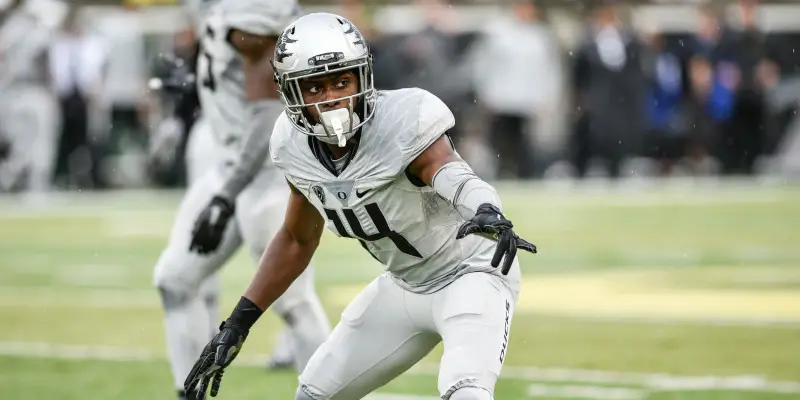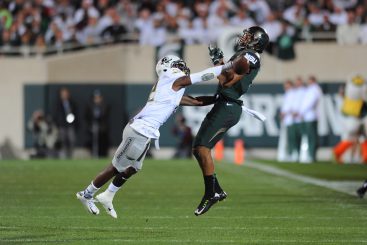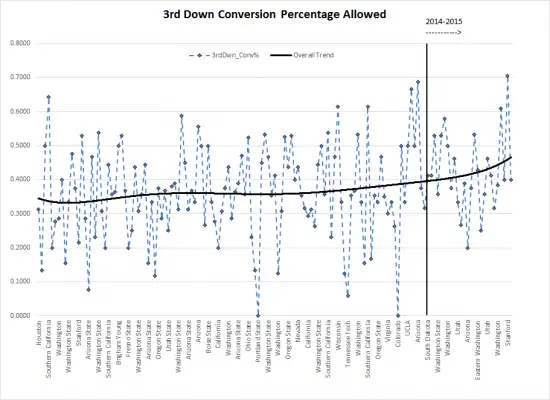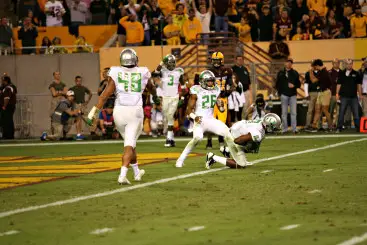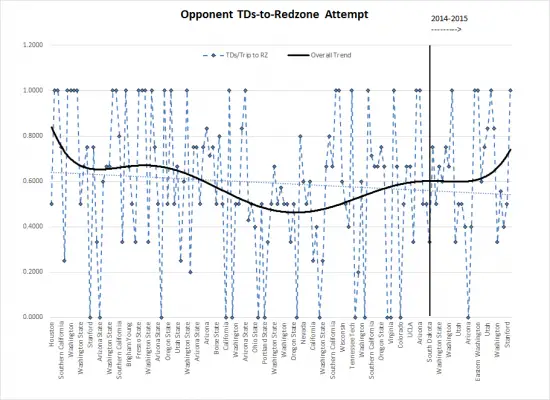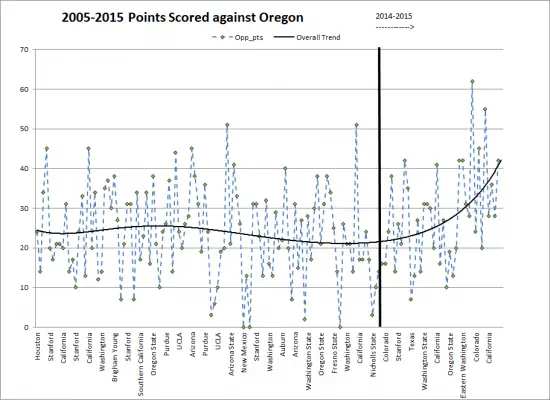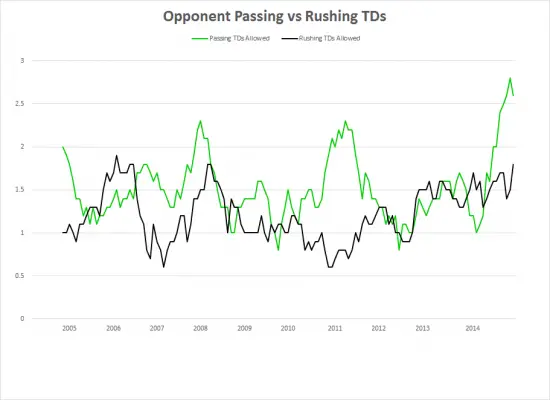In last week’s analysis I investigated Oregon’s yards allowed per play, an important statistic by which defenses are measured. Although important, however, yards per play does not define a defense. So this week I continue on my quest to discover how the Oregon defense has evolved over the past decade.
In future articles I intend to compare Oregon’s defense to other collegiate teams. For example, how does the Oregon defense compare to the defense of our Alamo Bowl opponent, TCU? But first, it is important to establish a baseline by comparing the 2015 defense to past Oregon defenses.
For example, if I told you that Oregon accounted for 54 passes defended over the 2015 season you would probably find that to be evidence of an active secondary. After all, Oregon is tied for 13th in the nation this year in passes defended with an average of 4.5 per game.
But how does that compare to last year? Well, last year Oregon’s secondary was fantastic, accounting for 71 passes defended for an average of 4.73 per game. This was good for 3rd in the nation for passes defended in 2014.
But what if I told you that Oregon’s secondary averaged nearly 24% more pass breakups over the 2010 and 2011 seasons? Over those two seasons, the Duck secondary broke up 81 and 74 passes, respectively, good for 1st nationally in both years. That is spectacular play in the secondary.
With those kinds of numbers it is hardly remarkable to observe a regression. However, passes defended don’t win football games if the opposing offense is still scoring.
And one of the reasons Oregon has ranked so highly in passes defended is because teams are often playing from behind. With the pace and volume that the Duck offense reaches the end zone, opposing teams are often forced to air it out in hopes of keeping up with Oregon’s frenetic scoring pace.
The Duck defense has always hung its hat on bending but not breaking. This means Oregon may allow plenty of first downs, but are intent on locking down the red zone once the field shortens and passing lanes become tighter.
There is plenty of statistical evidence of Oregon’s bend-but-don’t break style. Oregon has consistently and steadily allowed an increasing amount of third-down conversions over the last 10 years.
As you can see from looking at the chart, Oregon has been allowing more third-down conversions per attempt every year since the 2005 season. In 2005 the Ducks allowed opponents to convert 34.09% of third-down attempts, ranking 41st nationally. By the end of 2015 Oregon allowed a 43.07% conversion rate, ranking 101st nationally.
Much of this can likely be attributed to the nature of the Duck offense and Oregon’s corresponding defensive strategy. What really matters is red zone efficiency and points allowed.
The NCAA reports red zone defensive percentage as the total scores per attempt. However, I isolate opponent touchdowns per red zone attempt. While I acknowledge that field goals do win games, I think most would agree that forcing the opponent into a field goal instead of a touchdown in the red zone would constitute a defensive win for that possession.
In the next chart we can see the evolution of the Oregon’s defensive red zone efficiency.
By examining game-by-game red zone efficiency we can see that Oregon was very good in this category during the 2010 season. Over the 2010 season, the Ducks only allowed opponents to score a touchdown on 37.73 % of red zone attempts. It should be noted that the 2010 team was helped in this category by hosting both New Mexico and Portland State, which both went scoreless.
But even if we remove those two games, the 2010 average only increases to 44.49 %. In comparison, the 2015 defense allowed opponents to score a touchdown on an average of 73.38% of red zone attempts. While this is a stark increase compared to 2010, we can take solace in knowing that the 2005 defense allowed a touchdown on 78.47% of red zone attempts.
With all those red zone conversions, it might be interesting to take a look at how many total points Oregon has allowed over the past 10 years. Unfortunately, over the past 10 years, Oregon has never allowed more points than it has in this 2015 season.
As you can see in the chart above, the overall trend is fairly constant until we hit the 2015 season. From 2005-2013 Oregon allowed an eight-year average of 23.42 points allowed. In the 2014 season Oregon allowed 23.6 points per game, an insignificant uptick.
The 2015 season has been a different story. By allowing 36.75 points per game over the 2015 season the Oregon defense ranks 11th in the Pac-12 (on a positive note, the Beavers defense ranks 12th in the conference). You might be asking where all those points came from. Well, primarily they came from passing touchdowns, as shown in the following breakdown.
The above chart shows that the majority of touchdowns against Oregon this season came from through the air. In 2015, the Oregon defense allowed 33 touchdowns through the air and 21 on the ground. In comparison, the defense allowed only 21 passing touchdowns last season, along with 22 rushing touchdowns (and teams actually attempted more passes against the Ducks in 2014). No doubt the Oregon secondary was under fire this year.
One thing I have learned this year is that this team knows how to persevere in the face of adversity. The Oregon secondary has had its back against the wall all year long. They have given up big plays and plenty of points. But even as I question the Oregon defense, I remain encouraged by their potential. We all know the cupboard isn’t bare in Eugene.
Top photo by Kevin Cline
Related Articles:
Evan is a native Oregonian who grew up in the historic town of Oakland, once known as the Turkey capital of America. Evan attended the University of Oregon and is a Lundquist College of Business alumnus, and he has a Masters in Statistics and a PhD in Natural Resource Economics from University of Tennessee
While at Oregon he attended nearly every home football game and fostered his love for all things Oregon Duck. He now works for Ernst & Young amid the Huskies in downtown Seattle, and loves using his skills to study his beloved Ducks.

